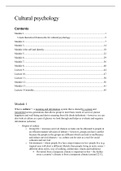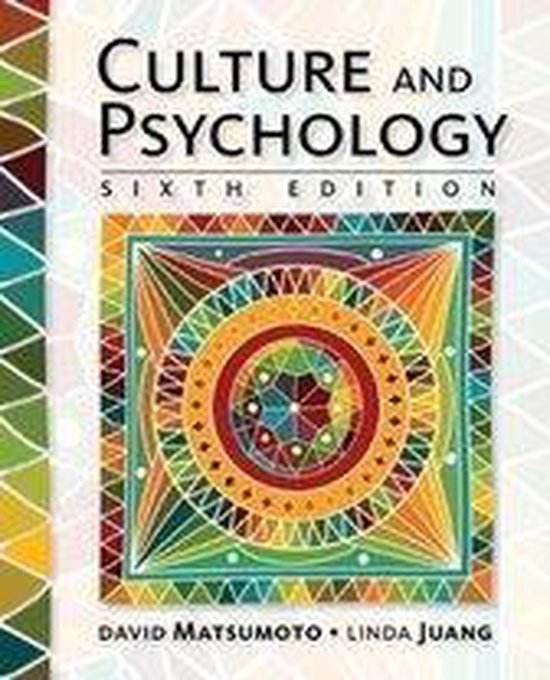Cultural psychology
Contents
Module 1....................................................................................................................................1
3 main theoretical frameworks for cultural psychology.........................................................5
Module 2....................................................................................................................................7
Module 3..................................................................................................................................14
Module 4 the self and identity..................................................................................................18
Module 5..................................................................................................................................22
Module 6..................................................................................................................................29
Module 7..................................................................................................................................36
Module 8..................................................................................................................................40
Lecture 9...................................................................................................................................44
Lecture 10.................................................................................................................................47
Lecture 11.................................................................................................................................50
Module 12................................................................................................................................56
Module 13................................................................................................................................61
Lecture 14 morality..................................................................................................................65
Module 1
What is culture? = a meaning and information system that is shared by a group and
transmitted across generations that allows group to meet basic needs of survival, pursue
happiness and well-being and derive meaning from life (book definition) > however, we can
also look at culture as a pair of glasses we look through and helps us evaluate and organize
information (schema)
- Origins of culture
o Group life > increases survival chances as tasks can be allocated to people in
an efficient manner (division of labour) > however, groups can have conflict
because the people in the groups are different which can lead to inefficiency
and reduce survival chances > so, culture can be seen as a tool for social
cohesion and survival
o Environment > where people live has a major impact on how people live (e.g.
tropical area will elicit a different lifestyle than people living in arctic zones >
different dress styles, way of walking, architecture, rituals and traditions)
Deviation from a temperate climate is important in this > the further
away a country’s climate is from a temperate climate (around 22 C),
, the more likely they will have differing practices etc to accommodate
that (e.g. Siesta in Spain, eating dinner at 11pm since it will be cooler
then)
Population density in relation to the amount of arable land = amount
of land on which food can grow to sustain people in that area
o Resources
E.g. void of natural resources may encourage teamwork and
community and form relationship with other groups that have an
abundance of the research you need
o The evolved human mind
Universal human needs are linked to reproductive success (eat, sleep,
drink, reproduce) and security needs (shelter, warmth, hygiene, safety)
> these are linked with social motives to achieve things and the motive
to affiliate with others
The universal psychological toolkit = the many abilities and aptitudes
that nature and evolution endowed humans with in order to help them
address their basic needs and social motives (and to adapt and survive)
Cognitive abilities: language, memory, hypothetical reasoning,
planning, problem solving, complex social cognition
o Shared intentionality = knowledge about motivations
concerning behaviours that are common among people
in a group (e.g. by reading their facial expressions)
o Ratchet effect = humans continually improve and they
do not go backwards or revert to a previous state
Emotions (including self-conscious and moral emotions)
Personality (OCEAN)
- So, culture results from the interaction among (1) our biological needs to survive, (2)
our universal social problems and (3) the context in which people live > culture helps
to select behaviours, attitudes, values and opinions that optimize our resources to meet
survival needs
- Human culture is different from animal culture
o Human culture is cumulative: knowledge, technology, tools etc cumulate over
time and continue to improve (ratcheting)
We also automate the process of knowledge and making tools
(institutionalization)
Some cognitive skills are uniquely human (learning through verbal
instruction, imitation)
Conceptualizing culture (knowledge clip)
- Seeing culture as:
o An independent variable = certain factors within a culture that influences
psychological phenomena (e.g. individualistic vs. collectivism)
o Confounding variable = culture does not play much of a role in psychological
phenomena as you assume these processes are universal (e.g. attachment
theory, cognitive development)
o Genuine psychological phenomenon = culture is inside one’s head,
psychological phenomena take place in a cultural context (e.g. Vygotski;
learning theory) > you can only understand that culture from within a place in
that culture itself
, o A Placeholder = we don’t necessarily know yet what role culture plays > e.g.
after a disaster in Japan, they were credited with ‘for a calm recovery’, then is
this because they are Japanese and therefore they respond in a calm manner or
not? > we don’t exactly know which role culture plays in this (in actuality, it is
more about the environment / level of preparation that Japan has for disasters
like that and not about the culture)
- Poortinga: hierarchy of interpretations > when faced with a certain situation and
wanting to explain it (e.g. why was Japan so calm in responding to a natural
disaster?), there are 6 steps you can go through to explain the situation > you want to
be as specific as possible when explaining so the goal is to move towards the lowest
number / tier (look for the most inexpensive answer)
o 1. Cultural values / traits > e.g. the Japanese do that because they are more
collectivist
o 2. Historical / political context > e.g. understanding the history Japan had to
go through (natural disasters, preparation trainings)
o 3. Cultural conventions
o 4. Other person / own person (group)
o 5. Situation
o 6. Behaviour
- Contextual cues are highly important to consider in culture studies > e.g. pen study
where participants fill out survey (unimportant) and after, they can choose 1 of 5 pens
where one is unique (has a different colour). During the normal selection procedure,
US people chose the unique pen more often than Japanese but when they have to take
context into account (they know that they are the first to choose a pen and people after
them will have to choose a pen from the remaining pens), the US participants were as
likely as the Japanese to choose the unique pen (they dropped in score) and if they
were the last to choose, it was also the same between US and Japanese > shows how
important it is to take into consideration contextual cues in making inferences about
how culture influences behaviour > so, without considering the environmental
context, we would probably arrive at wrong conclusions of behaviour that is expected
from US and Japanese people, based on what we know about their culture
Which human groups have cultures?
- Countries have their own cultures (nationality)
- Language groups have different cultures
- Ethnic groups have a culture
o Whereas race does not have a culture
- Gender has a culture
- Disability has a culture (people with a certain disability have unique psychological
and sociocultural experiences)
- Sexual orientation has a culture
Contents of a culture
- Objective elements = architecture, clothes, food, art etc.
- Subjective elements = attitudes, values, beliefs, behaviours
o Values = guiding principles that refer to desirable goals that motivate
behaviour (what is good, right and desirable)
Example: Hofstede model (see below)
, Sacred values = values that incorporate moral beliefs that are absolute
and outweigh other values (esp. economic ones) > e.g. you shouldn’t
cheat on your significant other
o Beliefs = a proposition that is regarded as true > cultural beliefs are social
axioms = general beliefs and premises about oneself, the social environment
and the spiritual world and they are assertions about the relationship between 2
or more entities / concepts (e.g. belief in a religion helps one understand the
meaning of life) > 2 dimensions of social axioms
Dynamic externality = outward-oriented, simplistic grappling with
external forces that include fate / a supreme being (good deeds will be
rewarded, bad deeds will be punished) > more collectivist,
conservative and hierarchical cultures
Societal cynicism = a cognitive apprehension or pessimism of the
world (e.g. caring about societal affairs only brings trouble upon
oneself, kind-hearted people usually suffer losses) > belief that the
world produces malignant outcomes
Religions = organized systems of beliefs that help people manage
themselves and their behaviours with others in order to avoid social
chaos and provide social coordination
o Norms = generally accepted standards of behaviour for any cultural group >
norms dictate behaviour that members of the culture have defined as the most
appropriate in any given situation
Rituals = culturally prescribed conduct / established procedure or
routine (e.g. having a cup of coffee in the morning, the bride being
walked down the aisle by the father)
Etiquette = behavioural patterns related to politeness (e.g. looking one
in the eye when talking shows respect in the US but may indicate a
challenge in a different culture)
o Attitudes = evaluations of things
o Cultural worldviews = culturally specific belief systems about the world that
contain attitudes, beliefs, opinions and values about the world
Cultural psychology is important because of WEIRD research (Western, educated,
industrialized, rich and democratic) and this is not representative of the world even though
almost all research comes from these countries (knowledge clip) > So, there is very little
evidence / no evidence for psychological phenomena that are taken as universal
- Henrich et al. makes 4 comparisons we can look at
o Modern industrialized vs. small scale societies
E.g. Muller-lyer illusion (arrows) > in African
countries, they rarely see this illusion (they say A
and B are the same length whereas Westerners do
not) > why is this? Carpentered world hypothesis
that says Western cultures are
surrounded by walls and angles
and so, we have an understanding
of depth perspectives and angles
whereas the African communities
have grown up without angular
walls






